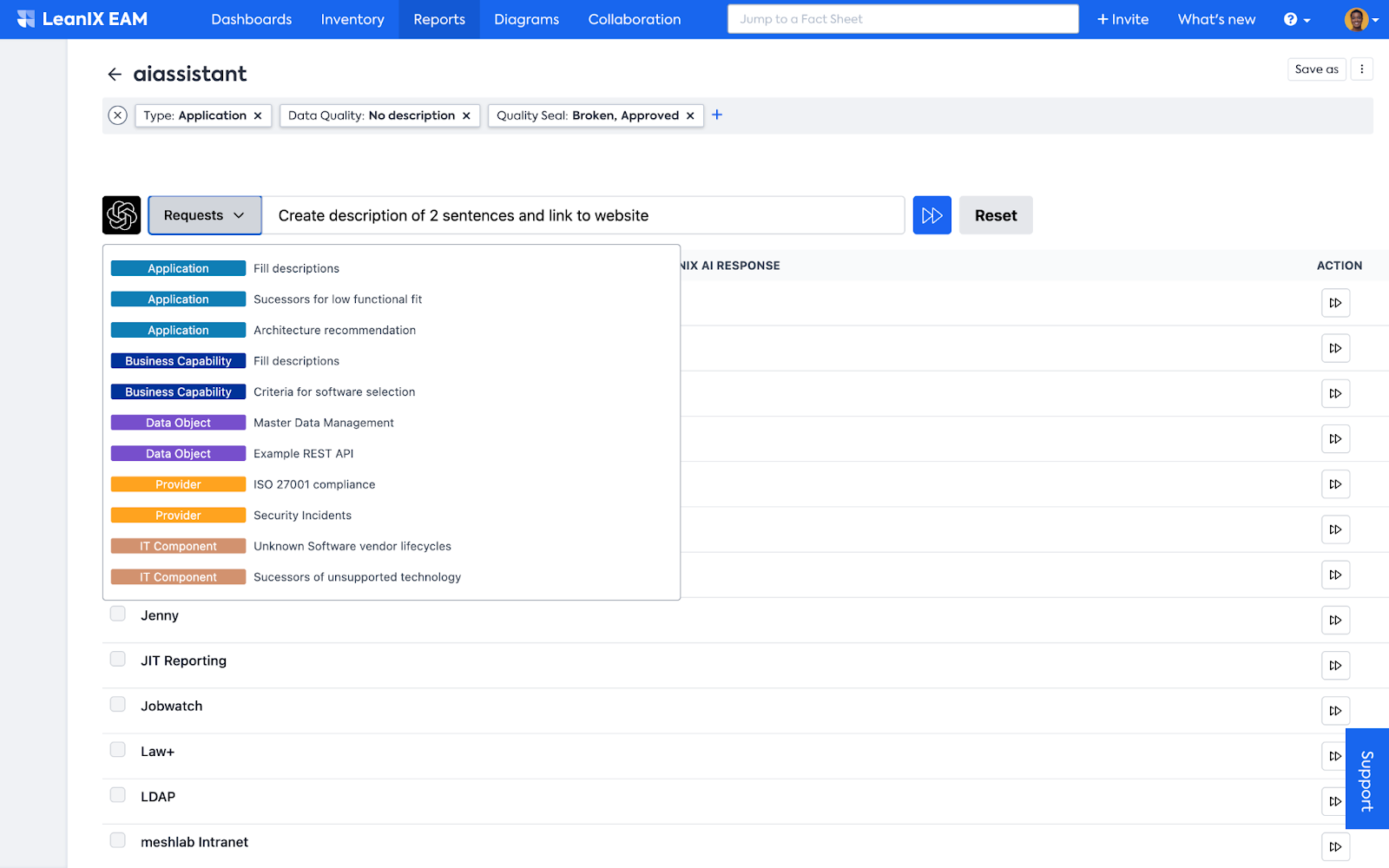
IaaS transformation creates the perfect landscape for leveraging the innovative powers of generative AI. Find out more about why Iaas and AI go hand-in-hand.
Infrastructure-as-a-service (IaaS) cloud options are a flexible way to maintain control of your IT landscape while still taking advantage of the opportunities that the cloud presents. Those opportunities include the innovations of generative artificial intelligence (AI).
LeanIX EAM can empower your IaaS transformation by supporting you in building a model of your IT landscape and a roadmap to transformation. To find out more about EAM, book a demo:
In the meantime, let's look more closely at IaaS, generative AI, and why the former is the perfect environment in which to leverage the latter.
What Is Generative AI And Why Should You Care?
Generative artificial intelligence (AI) is a technological innovation that allows a software program to create text, images, and even video from a description a user types in. You can ask it to create a whitepaper about your service, a new logo for your company, or a promotional video, often at a similar quality to what a human could create and in a fraction of the time.
In the digital age, with 24-hour news cycles and a turbulent market, creating enough content is becoming a challenge. Generative AI empowers organizations to rapidly create and iterate new messaging and marketing materials before the circumstances change and the message goes out of date.
In addition, machine learning empowers AI to research topics online and produce informative reports in just moments. By accessing data, AI tools can make insightful recommendations and even act on them itself, when empowered to do so.
This is a paradigm shift in the way organizations do business, with humans now acting as orchestrators for AI tools, rather than having to do the day-to-day tasks themselves. This will serve to scale up the capacity and speed that a company can operate to match the accelerating pace of change.
Keeping up with this new innovation will require organizations to undergo a business transformation and now is the time to make preparations for that. Could an infrastructure-as-a-service (IaaS) transformation be the key to unlocking the potential of generative AI?
IaaS, SaaS, or PaaS?
Cloud computing falls into three broad strategies regarding how much your organization entrusts control to external cloud vendors:
Software-as-a-service (SaaS) is where you maintain your tech stack, but leverage cloud-based applications for certain business capabilities. For example, you may have on-premise computing services run entirely by your team, but use web applications, such as Salesforce, Hubspot, or Basecamp.
Platform-as-a-service (PaaS) is the other extreme, where your entire computing service, storage, and application portfolio are hosted and managed by a cloud computing vendor. Here, you sacrifice control for ease and reduction in workload.
Infrastructure-as-a-service (IaaS) is the middle ground between SaaS and PaaS. Under an IaaS structure, you retain control over your IT set-up, while leaving the hosting and maintenance responsibilities to a vendor.
That's why IaaS is necessary for you to leverage the innovative potential of generative AI. Let's explore further what we mean by IaaS.
What Is IaaS?
Infrastructure-as-a-service (IaaS) is also sometimes called hardware-as-a-service. Essentially, the vendor will provide the cloud-based virtual hardware for your organization, while you choose the setup of your application portfolio.
Under an IaaS strategy, the responsibility for different aspects of your tech stack falls as follows:
Cloud Vendor
- Virtualization
- Servers
- Storage
- Networking
Your Organization
- Applications
- Data
- Runtime
- Middleware
- Operating system
IaaS gives you the freedom to architect, automate, deploy, and manage your application portfolio however you see fit within a cloud-based data center. At the same time, it frees you from having to buy and maintain your own hardware set, whether in the cloud or on-premise.
The key to understanding the IaaS strategy is to see it as moving from capital expenditure (CAPEX) to operating expenditure (OPEX). Instead of spending budget on physical assets that will depreciate in value over time, are hard to scale flexibly, and can be damaged by fires or natural disasters, you're subscribing to a virtual service that can be scaled while maintaining constant value.
This kind of flexibility will be key in leveraging generative artificial intelligence (AI) for the future of enterprise. Yet, there are many more advantages to an IaaS transformation, both for leveraging AI and otherwise.
The Benefits Of IaaS
Infrastructure-as-a-service (IaaS) is an ideal middle ground between software-as-a-service (SaaS) and platform-as-a-service (PaaS) strategies as it combines the best of both methodologies. The benefits IaaS provides include:
Scalability
The greatest advantage to IaaS is scalability. With SaaS, you still need storage space, and with PaaS you have a set group of tools, but with IaaS, you can scale your compute and storage to whatever you need to run the application portfolio you want.
This offers tremendous flexibility as you can easily retire applications or add more whenever you need without having to worry about server capacity. Changing your capacity is also almost instantaneous, whereas installing more servers or carting them away takes time, so IaaS can speed up development lifecycles and time-to-market.
Adding and removing compute capacity is so easy that it unlocks a variety of capabilities. With IaaS, you can quickly create testing and development environments, redundant servers, and capacity in other regions, allowing you to drive innovation and experiment with new technology like generative artificial intelligence (AI).
Improved Performance
An IaaS strategy has the joint advantages of empowering you to manage your own application toolset, allowing you to scale performance, and also decentralizing your server capacity. Cloud service means you won't have issues with your data center being too far away from your end-users.
You even have the capability to instantly create redundant servers in other regions and territories to enhance performance in distant locations. This means you can provision resources where you need them in minutes.
Greater range is particularly important after the rise of remote working. Now, server capacity across a large distance is vital for your employees to continue to work and collaborate.
IaaS is also particularly useful for organizations that regularly face spikes in traffic and load, such as ecommerce. Your control over your server capacity is so great that you can scale up during high demands periods and then scale back again when demand returns to normal.
Enhanced Business Continuity
Keeping all your servers in one data center is obviously a risk, particularly at a time where natural disasters are on the rise, pandemics have become worth provisioning against, and political upheaval can block access to certain locations with no prior warning. Virtual servers spread across the world allow you to keep your data and capacity safe, no matter what happens.
Innovation
Finally, and as we briefly touched upon, access to the cloud is key for exploiting the latest technologies. SaaS and application programming interface (API) tools are vital for modern commerce.
IaaS allows you to choose the applications that you believe will drive innovation and a competitive advantage for your business, but also supports you with the cloud-based connections you need to integrate them into your infrastructure. This is particularly the case with generative AI applications.
Using IaaS To Prepare For AI
Infrastructure-as-a-service (IaaS) creates the ideal landscape for generative artificial intelligence (AI). All the above advantages are perfect for driving the adoption of AI tools.
Generative AI systems like ChatGPT require a huge amount of compute and processing power. Rapidly establishing the server capacity you need and scaling it up to take advantage of AI tools, or back down if the tools become too expensive, is only possible with the flexibility of IaaS cloud computing.
Indeed, since AI is such a new innovation, it needs to be thoroughly tested before adoption. IaaS enables you to rapidly build test servers to calculate the potential of AI tools and then retire the servers once the test is complete.
Flexera reports that 90% of enterprises have adopted a multi-cloud strategy with numerous providers. An IaaS strategy like this enables you to silo datasets in different locations when needed.
This means that you can freely experiment with generative AI tools without exposing your confidential data to an untested technology. Nevertheless, the cloud capabilities of IaaS allow you to connect your AI tools across all the touchpoints you need to take full advantage of the technology.
How LeanIX Can Help

So, we've established that an infrastructure-as-a-service (IaaS) is the ideal way to prepare you to leverage generative artificial intelligence (AI). How do you go about it?
Well, the first step in any cloud transformation is discovering your current architecture and knowing what you need to move to the IaaS cloud and how. To do that, you need to build a complete map of your as-is estate, and a roadmap to get where you need to be.
Don't just take our word for it, however. LeanIX have, ourselves, been an early adopter of generative AI, and our new AI Assistant is available to all LeanIX customers. Add the Assistant to your LeanIX instance now.
If you're not a LeanIX customer, find out how we can support your IaaS transformation by booking a demo of our EAM:



